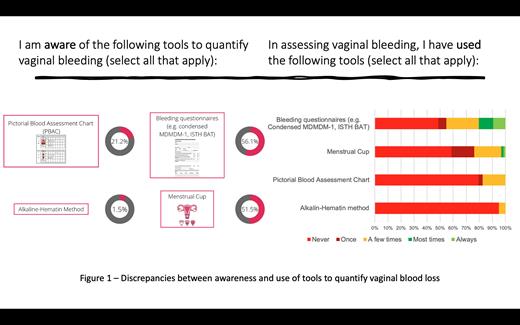Background - More than half of reproductive-age females experience heavy vaginal blood loss (VBL), whether menstrual, lochial, or otherwise, and yet less than 10% seek medical attention for evaluation. Moreover, there is evidence that even when females present to medical attention that heavy VBL is serially under-recognized and untreated. Complications from heavy VBL adversely impact health-related quality of life. This makes characterizing and quantifying VBL critical. It is well documented that there are widespread knowledge and care gaps surrounding VBL due to structural multidimensional stigma. Importantly, it is unclear the extent to which medical learners confidently recognize symptoms and signs of heavy VBL.
Objectives - To explore the understanding, attitudes, and perceptions of medical learners in characterizing VBL using an online survey.
Methods - An online survey was launched to assess trainees' ability to identify heavy VBL. Survey questions were informed by the literature and tested for validity. The survey was distributed online to trainees working at all local University affiliated hospitals. Results were analyzed using descriptive statistics. Institutional ethics approval was obtained.
Results - 73 learners (medical students, residents, and fellows) completed the survey. 88% of learners were between the ages of 25-34, and 56% self-identified as women. 27% were 3rd /4th level medical students, 30% were 2nd year residents, 43% 4th year residents or higher. 27% of residents were from Emergency Medicine, 14% Hematology, 12% Family Medicine, 10% Internal Medicine, and 10% Obstetrics and Gynecology. 94% of trainees reported asking about heavy VBL in the last 6 months. Most described feeling comfortable asking about and diagnosing VBL regardless of cultural, religious or ethnic background, sexual orientation, or gender. 56% were aware of bleeding assessment tools (BATs), 51% of menstrual cups, 21% of the pictorial bleeding assessment chart (PBAC) however, less than 60% had used BATs, less than 75% had used menstrual cups and less than 80% had used the PBAC in clinical practice (Figure 1). Overall, trainees acknowledged stigma surrounding iron deficiency without anemia, and that iron deficiency was associated with decreased health-related quality of life. They recognized the need to screen and not rely on patients being forthcoming about excessive VBL.
Discussion - Heavy VBL is exceedingly common, has important clinical and psychosocial ramifications, yet it continues to be stigmatized, underdiagnosed, and thus poorly treated. We found that while a broad range of medical learners described themselves as largely feeling comfortable with their skills in assessing VBL and being aware of tools to facilitate the diagnosis of heavy VBL, surprisingly few had used these tools in clinical practice. Our findings highlight important knowledge gaps surrounding VBL and interestingly, show excessive confidence in its diagnosis amongst medical learners. Targeted knowledge translation rooted in theory- and evidence-based implementation science is urgently required in this space. Next steps involve assessing trainee skills in practice and exploring patient lived experiences with VBL through qualitative interviews.
Disclosures
Sholzberg:CSL Behring: Research Funding; Pfizer: Honoraria, Research Funding; Octapharma: Honoraria, Research Funding.


This feature is available to Subscribers Only
Sign In or Create an Account Close Modal